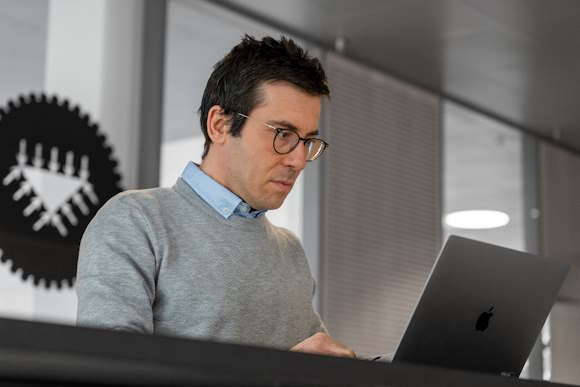
Creating the Brains of Tomorrow’s Robots
Big robots, small robots, household robots, surgical robots. Size and function don’t really matter—what matters to Melih Kandemir is developing algorithms that can make robots more precise and safer than they are today.
At the breakfast table, you’ll reach out your cup. Your personal assistant will get up, fetch the coffee pot from the kitchen, and pour you a steaming mug.
Your personal assistant will look like a human but it will be a robot. It has moved in with you to take care of everything you find too boring or tedious to do yourself: brew coffee, iron clothes, clean windows, uncork the wine, unpack groceries.
For computer scientist Melih Kandemir, such robots will become a natural part of our future. We’ll see more robots in our homes, workplaces, and in the healthcare sector.
“But we need to trust—completely—that robots are safe and precise. We’re not there yet. Not even close,” he says.
Robots learn like us
According to the Turkish-born associate professor and Principal Investigator at the Department of Mathematics and Computer Science, robots must be so accurate and dependable, that they pose no risk - no spilled coffee in your lap, no shirts burned by an iron, no groceries scattered across the kitchen floor. And on the serious end of the spectrum: No crashes in a self-driving car, no surgical errors from hospital robots.
That’s why Melih Kandemir focuses his research on the algorithms that instruct robots in what to do. It’s about machine learning, specifically the subfield of reinforcement learning — a method where machines learn in a way similar to humans: by trial and error.
In reinforcement learning, the machine is told what the desired outcome of a task should be (e.g., getting from point A to B), but it must figure out on its own how to get there—whether to walk, run, or crawl. Over time, the machine will learn the most efficient way to go from A to B.

Melih Kandemir
Melih Kandemir is an associate professor at Dept. of Mathematics and Computer Science. He is the founding principal investigator of the SDU Adaptive Intelligence Laboratory (ADIN Lab), where theoreticians and applied researchers work together. The mission of the lab is to discover the algorithmic fundamentals of lifelong adaptation in robotic systems. Melih is also the founding head of the SDU Centre for Machine Learning. Prior to his current role, Melih was leading a research group at Bosch Center for Artificial Intelligence in Germany. Melih has published more than 50 research articles, and his current research is funded by the Novo Nordisk Foundation, the Carlsberg Foundation, and the Independent Research Fund Denmark.
“My approach is unique; In my lab, theoretical and applied researchers collaborate closely to find well-understood and trustworthy methods to complex real-world problems. We need excellent applied researchers to keep our feet firm on the ground and theoreticians to reach as high as possible on the sky”, he says.
To even begin learning through reinforcement learning, a machine must be programmed with an algorithm to guide the learning—and that’s where Melih Kandemir´s passion lies:
“I’m interested in developing algorithms that can give us 100% precise and 100% safe robots. 99.9% isn’t enough for me when it comes to, say, being in a self-driving car.”
Robots also need to learn what NOT to do
Part of Kandemir’s research also focuses on teaching machines what not to do—so they will not act unpredictably or harmfully. This falls within machine learning theory, where Kandemir and his colleagues use mathematics to define boundaries for what an algorithm must never be able to do.
But how can a robot learn to transport us in a self-driving car or operate on us in a hospital, when—for obvious reasons—we can’t let it practice on unsuspecting passengers and patients?
“We can do this in simulators—virtual environments where robots can train everything they need to learn. It works just like in a video game, where you see the world from the player’s point of view—like in Counterstrike. The environment might be a living room or a kitchen where the robot practices tidying up. Another method is letting robots learn by observing how humans do things, before attempting the task themselves.”
The real star are the algorithms
For Kandemir, algorithms are the real star of the show. Whether they will run a giant industrial robot or a microscopic device, he´s less concerned with form and more with function – and the potential to benefit humanity.
“Micro-robots could be sent into the body to hunt down and destroy cancer cells. Tiny robots could be implanted in the brains of patients with neurological diseases to keep neural networks active, allowing them to live normal lives again. And personal robotic assistants – what we call ‘egocentric assistants’ – could play a huge role in eldercare. They focus entirely on one person, learning their routines and needs and follow them everywhere.”
Kandemir emphasizes that it’s not about replacing or making doctors and caregivers obsolete—it’s about freeing up more of their time.
The real world’s problems are the most important
He also stresses the importance of practical impact in research:
“That’s a driving force for me—that my research can make a difference for real people. In my research group, we often try to imagine what systems based on artificial intelligence will look like in 20 years. Then we work backward from there, and that gives us a good idea of what we need to be researching today.”
Again, it’s all about making research useful and practical:
"My lab's mission is to solve root problems that cross cut many problems we observe in our daily lives. We are not interested in working on made up problems that may look fun to work with but have no real value."